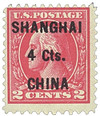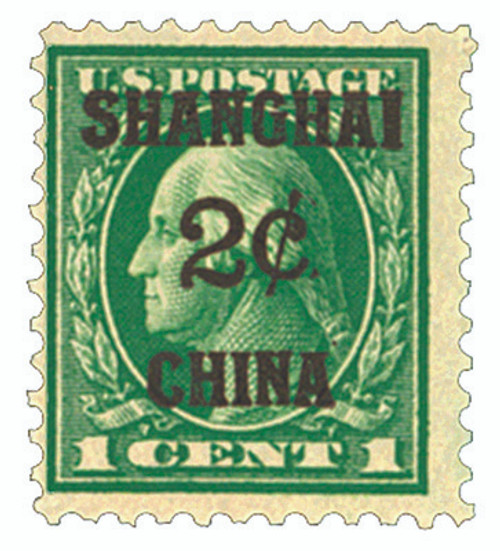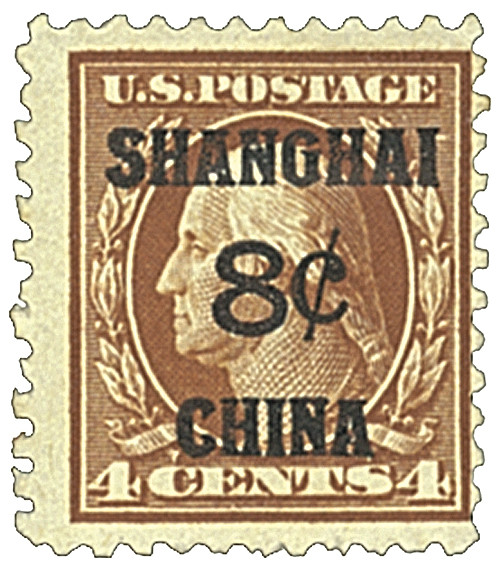
# K18 - 1922 4c on 2c Carmine, Shanghai Overprint
Expand Your Collection
With Shanghai Stamps
In 1839, the Chinese government seized 20,000 chests of opium from the British. Thus began the Opium Wars. Great Britain had been smuggling opium into China, creating huge economic and social problems for China. China, in return, had refused to allow importation of any foreign goods, while it exported silk and tea in large quantities. The British, with their mighty naval forces, easily defeated the Chinese. In 1842, the Opium War between China and Great Britain came to an end.
The result of this struggle was a series of treaties which the Chinese referred to as the unequal treaties. Great Britain established colonies for itself in these treaties. One of them was Shanghai. Located on the Huangpu River, Shanghai has been a critical trading port throughout history. Shanghai has a population of about 12 million people, making it the largest city in China. When it was forcibly opened to trade in 1842, western missionaries and traders from Britain, France, and the U.S. established themselves in Shanghai. These foreign influences gave parts of Shanghai a vaguely Western appearance.
The United States attained access to this rich trading port in 1863 through territorial concessions from the British. Until 1919, regular U.S. postage was used in Shanghai. In 1919, the demand for U.S. postage was sufficient to require stamps with the surcharge “Shanghai China” to be issued at the U.S. post office in Shanghai. A surcharge, like an overprint, is applied to the stamp after the stamp has been produced. Unlike an overprint, however, which changes the commemorative purpose of a stamp, a surcharge changes the stamp’s denomination or face value. All of the Shanghai surcharges were twice the value on the stamp. The exchange rate at the time was one U.S. dollar to two Shanghai dollars.
The two locally surcharged stamps were overprinted in Shanghai. They were the result of a shortage created when stamps from the U.S. failed to arrive.
Although postal agencies also existed in Tientsin and Ningpo, the Shanghai Postal Agency operated for the longest period of time. Established in 1867, it remained in business until December 31, 1922.
Expand Your Collection
With Shanghai Stamps
In 1839, the Chinese government seized 20,000 chests of opium from the British. Thus began the Opium Wars. Great Britain had been smuggling opium into China, creating huge economic and social problems for China. China, in return, had refused to allow importation of any foreign goods, while it exported silk and tea in large quantities. The British, with their mighty naval forces, easily defeated the Chinese. In 1842, the Opium War between China and Great Britain came to an end.
The result of this struggle was a series of treaties which the Chinese referred to as the unequal treaties. Great Britain established colonies for itself in these treaties. One of them was Shanghai. Located on the Huangpu River, Shanghai has been a critical trading port throughout history. Shanghai has a population of about 12 million people, making it the largest city in China. When it was forcibly opened to trade in 1842, western missionaries and traders from Britain, France, and the U.S. established themselves in Shanghai. These foreign influences gave parts of Shanghai a vaguely Western appearance.
The United States attained access to this rich trading port in 1863 through territorial concessions from the British. Until 1919, regular U.S. postage was used in Shanghai. In 1919, the demand for U.S. postage was sufficient to require stamps with the surcharge “Shanghai China” to be issued at the U.S. post office in Shanghai. A surcharge, like an overprint, is applied to the stamp after the stamp has been produced. Unlike an overprint, however, which changes the commemorative purpose of a stamp, a surcharge changes the stamp’s denomination or face value. All of the Shanghai surcharges were twice the value on the stamp. The exchange rate at the time was one U.S. dollar to two Shanghai dollars.
The two locally surcharged stamps were overprinted in Shanghai. They were the result of a shortage created when stamps from the U.S. failed to arrive.
Although postal agencies also existed in Tientsin and Ningpo, the Shanghai Postal Agency operated for the longest period of time. Established in 1867, it remained in business until December 31, 1922.









